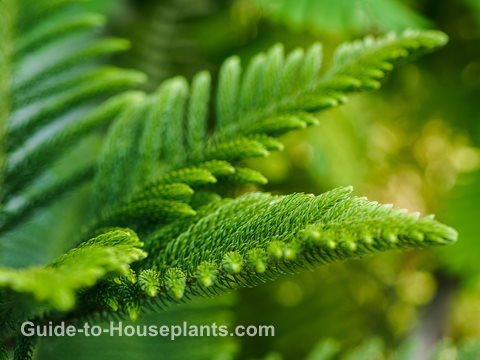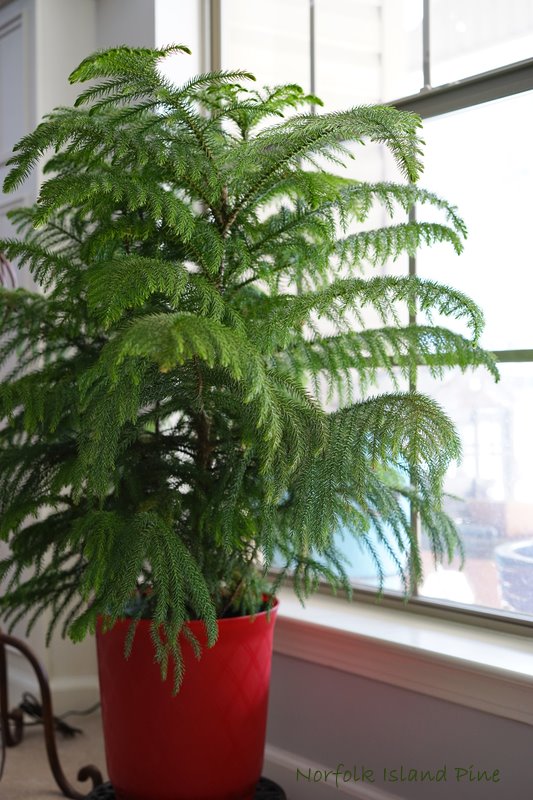Growing Norfolk Island Pine Indoors
Botanical Name: Araucaria heterophylla
It's easy to find Norfolk Island Pine for sale around the holidays. Young trees show up on florists' and garden center shelves before Christmas and are popular as gifts or décor.
Don't toss it out after the holidays are over, however. With good care, your pint-sized tree will thrive beautifully indoors for many years. In this guide, you'll discover how much light this handsome houseplant wants, when to water, and how to prevent its needles from dropping.
 Norfolk Island pine is tropical, and it loves warm temperatures and moist air.
Norfolk Island pine is tropical, and it loves warm temperatures and moist air.Get to Know Norfolk Island Pine
Araucaria heterophylla is an evergreen conifer that makes a handsome houseplant. Its long, horizontal branches are densely covered with short, soft needles that become darker as the plant ages.
This plant not a true pine, it just looks like one. It also gets its name from Norfolk Island -- a small island in the Pacific between Australia, New Zealand and New Caledonia.
In its native habitat, Norfolk Island pine can grow up to 200 ft (60 m) tall. As a house plant, you can expect it to reach about 3-6 ft (90 cm - 1.8 m). Slow-growing, it will take several years to reach this height.
To understand how to care for these plants, remember their native environment, where they enjoy moderate temperatures, moist air and bright light. Dry air, dry soil and low light can cause the needles to drop -- and they won't grow back. They need a little extra attention, but they're worth it. Norfolk pine trees will live a long time with good care.
You'll find Norfolk Island pine trees for sale from online nurseries and some garden centers in spring and summer. Small trees are sometimes decorated and sold around Christmastime.
Norfolk Island Pine Care
Green Thumb Tip
If you move your plant outdoors for the summer, keep it shaded from hot sun. Check the soil often and keep it moist. Norfolk pine is frost tender. In fact, it doesn't like the cold at all. Bring it back indoors if the temperature drops below 50°F/10°C.
Raise the humidity. Dry air will cause the needles to become dry and fall off. Keep your plant away from heat/AC vents. This Pacific Island native loves to be misted with room-temperature water. Or use a cool-mist room humidifier to add moisture near this tropical native.
Keep soil moist. Growing Norfolk Island pine trees are thirsty, so check the soil often during the growing season. Yellow needles are typically caused by soil that's either too dry or soggy. Aim to keep it lightly moist at all times.
Repot in spring. This plant is slow-growing, especially indoors. Move it into a pot 1 size larger every 3 years or when roots are visible on top of the soil. Norfolk pine doesn't like to be disturbed, so repot only when necessary. Want to cover up a plain nursery pot? Slip it into a decorative cachepot. When the tree grows to more than 3 ft (90 cm) tall, top dress instead.
How to Top Dress: Remove the top 2-3 inches of soil and replace with fresh soil every couple years. Take care not to harm any roots that may be near the surface.
Don't prune Norfolk pine. Never cut off the top or trim the sides of this plant. It doesn't need to be shaped at all. You can remove any lower branches that die, using sharp pruners to prevent tearing the stems.
Watch for pests. Not many house plant pests bother Norfolk pines. Mealybugs are the most common. Watch for white, cotton-like areas on leaves and stems and treat any infestation immediately.
 Give your Norfolk Island pine plenty of light and it'll grow beautifully indoors. Photo © Linda Williams
Give your Norfolk Island pine plenty of light and it'll grow beautifully indoors. Photo © Linda WilliamsCaring for Norfolk Pine Tree
Origin: Norfolk Island
Height: Up to 6 ft (1.8 m), grown in a pot indoors
Light: Bright light with some full sun. Rotate the pot occasionally in front of the window to give all sides light for even growth.
Water: Keep the soil evenly moist in the spring and summer; lightly moist in winter, when growth is slower. Water regularly to prevent loss of needles. Always use tepid water for watering your houseplants because cold water is a shock to them.
Humidity: Moderate room (50% relative humidity) or higher. The most efficient way to boost humidity for your tropical plants is to use a small cool-mist humidifier. Indoor air can become extremely dry in the winter months. It's a good idea to use a humidity monitor near your houseplant rather than guess. Dry, yellowing needles are a sign the air is too dry.
Temperature: Average room temperatures 65-75°F/18-24°C. Norfolk Island pine doesn't like the cold, so don't expose it to temps below 50°F/10°C. Remember to keep your Norfolk Pine away from blasts of cold air and furnace vents.
Soil: Soil-based potting mix
Fertilizer: Feed every 2 weeks spring through fall with a balanced water-soluble fertilizer diluted by half.
Propagation: Can be grown from seed, although it will take several years to reach the size of a purchased plant.


